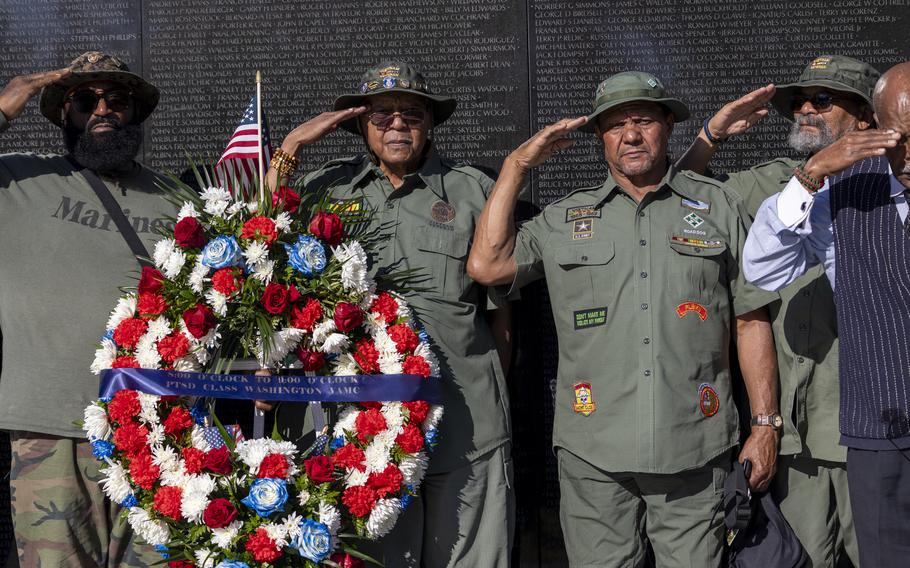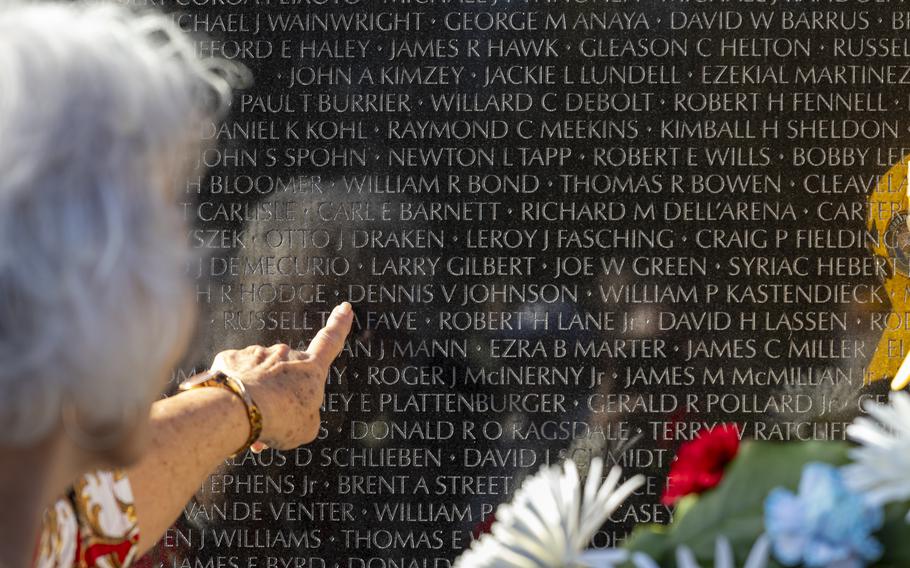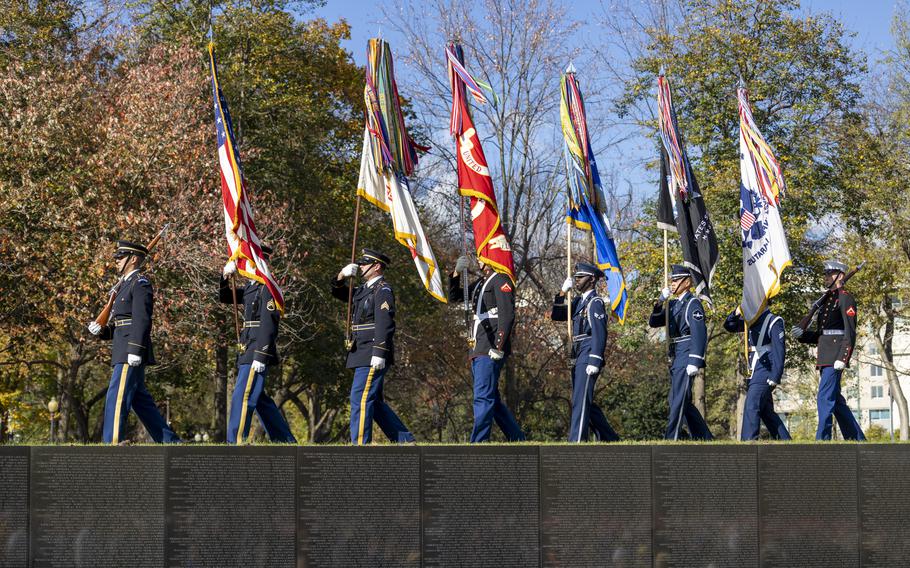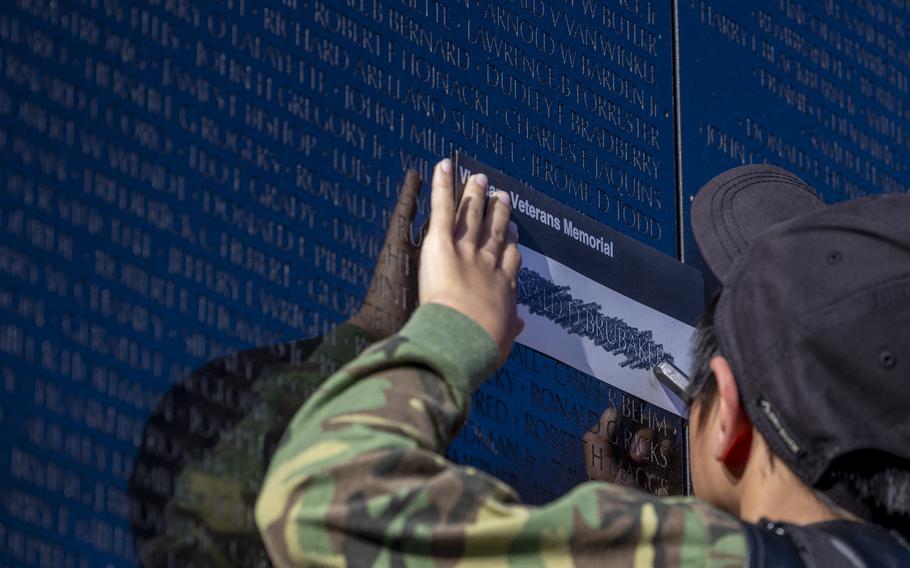
From left, veterans Noah Miller Mack, who was a sergeant in the Marine Corps, Anthony Mustifa, who was a sergeant in the Air Force, Nelson King, who was a specialist 4 in the Army, and Lloyd Hart, was a sergeant in the Army, salute during the playing of taps at the Vietnam Veterans Memorial in Washington during the Veterans Day at The Wall event on Monday, Nov. 11, 2024. (Eric Kayne/Stars and Stripes)
WASHINGTON — The keening notes of “Amazing Grace” reverberated at the granite walls of the Vietnam War Memorial as Army veteran Christian Jackson sounded his bagpipe at the close of the Veterans Day ceremony.
Standing on a slope right above the memorial, Jackson ended an emotional commemoration that honored the fallen soldiers whose names are etched on the wall but also paid tribute to veterans and their loved ones who attended the anniversary celebration Monday.
“You’re seen, you’re honored, you’re appreciated,” Jeff Reinbold, superintendent of the National Mall and Memorial Parks, said to the more than 200 visitors at the start of the 90-minute ceremony at the memorial, the most visited war monument on the mall.
But the celebration also paid tribute to two lesser-known memorials at the site — marking the 40th anniversary of the dedication of the Three Servicemen statute and the 20th anniversary of the In Memorial plaque.
The Three Servicemen statue by sculptor Frederick Hart depicts men in uniform standing in watch at the memorial. The bronze statute was completed in 1984, just two years after the Vietnam memorial opened.
“The statue shows the faces of the war fighters,” said Jackson, who stood outside the war memorial site, practicing “Amazing Grace” before the event.
This is the 27th year that he has played at the Veterans Day ceremony, he said.
“It is important that the GIs who served are never forgotten,” said Jackson, a former first lieutenant who served in the Army from 1983-1994.

An attendee points to a name on the Vietnam Veterans Memorial in Washington during Veterans Day at The Wall event on Monday, Nov. 11, 2024. (Eric Kayne/Stars and Stripes)
The In Memorial plaque, made from black granite, honors Vietnam veterans who died after the war from injuries sustained while on active duty. These soldiers fall outside the Defense Department’s guidelines for inscription on the wall.
Taken together, the monuments help to tell a story of military service and sacrifice during the Vietnam War, said Robert Doubek, keynote speaker at the ceremony.
Doubek, an Air Force veteran who helped to establish Vietnam Veterans Memorial, described the Three Servicemen’s statute as a heroic and traditional portrayal of military duty that reveals the pressures of combat.
Doubek served for four years as an intelligence officer, including a year in Vietnam in the late 1960s.
The statue is a contrast to Maya Linn’s minimalist design of the black granite wall at the memorial, he said.
“I was there. Twenty-three of my friends were killed there,” said Steve Ammon, an 83-year-old Army veteran who sat in his wheelchair studying the Three Servicemen statue before the ceremony started.
His wife, Mary Jo Ammon, and daughter, Kelly Krek, stood silently behind him.
“So much was different about how the war was fought in Vietnam,” said Ammon, a former lieutenant colonel who served in the military for 23 years, retiring in 1983.
“Often there were small groups of soldiers — three or four like this — walking alone in the jungle,” he said pointing to the statue.
Ammon said attending the ceremony was important because he felt a connection to the other veterans who made the pilgrimage on Veterans Day.

The presentation of colors Monday, Nov. 11, 2024, during the Veterans Day at The Wall event at the Vietnam Veterans Memorial in Washington. (Eric Kayne/Stars and Stripes)
“It makes me feel good to be here,” said Army veteran Joe Harshberger, 77, of Pennsylvania.
Harshberger, a former corporal, also paused at the statue. He said the monument reminded him of his own military service in Vietnam. Harshberger said he got his draft notice a month after graduating from high school. He served from 1967 to 1968.
“I have many friends whose names are on the wall. I come to pray for them,” he said

Volunteer Thanh Phung, 11, makes a wall rubbing of a name on the Vietnam Veterans Memorial in Washington during Veterans Day at The Wall event on Monday, Nov. 11, 2024. (Eric Kayne/Stars and Stripes)
Jackson, a retired police officer, said he sees the statue as a reminder of the heroism of all first responders.
“I come from a family of soldiers, sailor, cops and firemen,” he said. “It is important that the service and contribution of these men and women are not forgotten.”